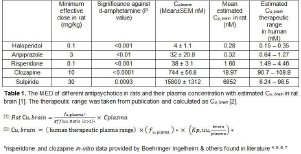Print version
Search Pub Med
- R. Kabir1
- 2
- D. Schnell3
- J. Freudenreich2
- A. Ceci2. 1School of Biological Sciences
- University of Manchester
- Manchester
- United Kingdom
- 2CNS Diseases Research
- Boehringer Ingelheim Pharma GmbH & Co. KG
- Biberach an der Riá
- Germany
- 3Drug Discovery Sciences
- Boehringer Ingelheim Pharma GmbH & Co. KG
- Biberach an der Riá
- Germany
| 002P London, UK Current trends in Drug Discovery – Young Scientists and Tomorrow’s Medicines |
Back-translation from clinic to animal test: efficacy of current and past antipsychotics in the attenuation of d-amphetamine induced hyperlocomotion in Wistar-Han rats
Introduction: D-amphetamine induces symptoms of psychosis like those of schizophrenia in healthy individuals and aggravates them in schizophrenic patients1. Locomotor activity (LMA) in rodents can be manipulated during investigation of pharmacological agents concerning mania2. The aim of the present study was to investigate the pharmacodynamics of clinically-used antipsychotics in a drug-induced animal test, evaluating the clinical back-translation of these antipsychotics. The D2-selective antagonist sulpiride was utilized as a negative control due to its poor blood-brain-barrier permeability thus lack of effect at low doses3.
Methods: Adult male Wistar-Han rats were randomly grouped into dose groups/ saline alone ± d-amphetamine per antipsychotic (n=8) respectively. Rats were habituated in LMA arenas for 60-min prior to antipsychotic pretreatment of haloperidol (0.03, 0.1, 0.3), risperidone (0.1, 0.3, 1), clozapine (1, 3, 10, 30), aripiprazole (1, 3, 10, 30) and sulpiride (1, 3, 10, 30, 100) [s.c./i.p. mg/kg]. After 30-min, d-amphetamine was injected (s.c.) and data was recorded for 210-min. The total ambulatory move time was measured using TruScan-2 (Coulbourn-Instruments). Plasma was taken 60-min post-antipsychotic administration in satellite rats of similar weight, sex and age for HPLC analysis. The data is given as mean±SEM and analysed via one-way ANOVA with Dunnett’s test.
Results: A dose-finding study indicated 1.5 mg/kg d-amphetamine as the active dose against antipsychotics to be tested. A dose-response was demonstrated with all antipsychotics apart from sulpiride (doses < 30 mg/kg). The minimum effective dose (MED) showing significant attenuation of amphetamine-induced hyperlocomotion with plasma exposure was determined for free drug concentration calculation (Cu,brain) (Table 1).

Conclusion: The results above indicate hyperlocomotion targeted pharmacodynamics and display the estimated Cu,brain in rat at MED of all apart from sulpiride is within 5-fold range of estimated Cu,brain of the known therapeutic plasma range in humans. Clozapine disconnection could be attributed to species differences in metabolism and active metabolites. As the pre-clinical correlates with clinical exposure, it suggests that this amphetamine-induced hyperlocomotion behavior test is suitable for pre-clinical MED for novel antipsychotics.
References:
1. Bramness J. et al. (2012). BMC Psychiatry 12: 221
2. Forrest A. et al. (2014). Curr Behav Neurosci Rep. 1: 100-116
3. Rich T. (1984). Med Hypotheses 14: 69-81
4. Nagasaka Y. et al. (2012) Biopharm Drug 33: 304-315
5. Culot M. et al. (2013) PLOS ONE 8: e80634
6. Bundgaard C. et al. (2012) Drug Met & Disp 40: 461-466
7. Kodaira H. et al. (2011) J Pharm & Exp Ther 339: 935-944

